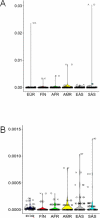Apparent underdiagnosis of Cerebrotendinous Xanthomatosis revealed by analysis of ~60,000 human exomes
- PMID: 26643207
- PMCID: PMC4767010
- DOI: 10.1016/j.ymgme.2015.10.010
Apparent underdiagnosis of Cerebrotendinous Xanthomatosis revealed by analysis of ~60,000 human exomes
Abstract
Cerebrotendinous Xanthomatosis (CTX) is a treatable inborn error of metabolism caused by recessive variants in CYP27A1. Clinical presentation varies, but typically includes infant-onset chronic diarrhea, juvenile-onset bilateral cataracts, and later-onset tendinous xanthomas and progressive neurological dysfunction. CYP27A1 plays an essential role in side-chain oxidation of cholesterol necessary for the synthesis of the bile acid, chenodeoxycholic acid, and perturbations in this gene that reduce enzyme activity result in elevations of cholestanol. It is commonly held that CTX is exceedingly rare, but epidemiological studies are lacking. In order to provide an accurate incidence estimate of CTX, we studied the ExAC cohort of ~60,000 unrelated adults from global populations to determine the allele frequency of the 57 variants in CYP27A1 reported pathogenic for CTX. In addition, we conducted bioinformatics analyses on these CTX-causing variants and determined a bioinformatics profile to predict variants that may be pathogenic but have not yet been reported in the CTX patient literature. An additional 29 variants were identified that met bioinformatics criteria for being potentially pathogenic. Incidence was estimated based allele frequencies of pathogenic CTX variants plus those determined to be potentially pathogenic. One variant, p.P384L, previously reported in three unrelated CTX families had an allele frequency ≥ 1% in European, Latino and Asian populations. Three additional mutations had a frequency of ≥ 0.1% in Asian populations. CTX disease incidence was calculated excluding the high frequency p.P384L and separately using a genetic paradigm where this high frequency variant only causes classic CTX when paired in trans with a null variant. These calculations place CTX incidence ranging from 1:134,970 to 1:461,358 in Europeans, 1:263,222 to 1:468,624 in Africans, 1:71,677 to 1:148,914 in Americans, 1:64,267 to 1:64,712 in East Asians and 1:36,072 to 1:75,601 in South Asians. This work indicates CTX is under-diagnosed and improved patient screening is needed as early intervention prevents disease progression.
Keywords: Bile acids; Bioinformatics; CDCA; CTX; Cataract; Cholestanol; Cholic acid; IEM; Incidence; Population genetics; Sterol; Xanthoma.
Copyright © 2015. Published by Elsevier Inc.
Figures


References
-
- Berginer VM, Salen G, Patel SB. Cerebrotendinous Xanthomatosis. In Rosenberg's Molecular and Genetic Basis of Neurological and Psychiatric Disease. In: Rosenberg RN, Pascual JM, editors. Academic Press; Elsevier: 2015. pp. 589–598.
-
- Bonnen PE, Yarham JW, Besse A, Wu P, Faqeih EA, Al-Asmari AM, Saleh MA, Eyaid W, Hadeel A, He L, Smith F, Yau S, Simcox EM, Miwa S, Donti T, Abu-Amero KK, Wong LJ, Craigen WJ, Graham BH, Scott KL, McFarland R, Taylor RW. Mutations in FBXL4 cause mitochondrial encephalopathy and a disorder of mitochondrial DNA maintenance. Am J Hum Genet. 2013;93:471–481. - PMC - PubMed
-
- Chen W, Kubota S, Teramoto T, Nishimura Y, Yonemoto K, Seyama Y. Silent nucleotide substitution in the sterol 27-hydroxylase gene (CYP 27) leads to alternative pre-mRNA splicing by activating a cryptic 5′ splice site at the mutant codon in cerebrotendinous xanthomatosis patients. Biochemistry. 1998;37:4420–4428. - PubMed
Publication types
MeSH terms
Substances
Grants and funding
LinkOut - more resources
Full Text Sources
Other Literature Sources
Miscellaneous

